-

人教版新目标初中英语九年级上册Where would you like to visit教案2篇
The First PeriodⅠ.Teaching Aims and DemandsKnowledge Objects(1) Key Vocabularytiring, educational, fascinating, thrilling, peaceful, exotic, trek, jungle, take it easy, explore, historic, site(2) Target LanguageWhere would you like to go on vacation?I’d like to trek through the jungle, because I like exciting vacations.2. Ability Objects(1)Train students to talk about places they would like to visit with the target language.(2)Train students to describe vacations with different adjectives.(3)Train students' listening skill.3. Moral Object,It′s more interesting to go on vacating somewhere instead of staying at home.Ⅱ. Teaching Key Points1. Key Vocabularytiring, educational, fascinating, thrilling, peaceful, exotic, trek, jungle, take it easy, explore, historic, site2. Target LanguageTalk about different places with the target language.Ⅲ. Teaching Difficult Points1. Describe vacations with different adjectives.2. Talk about different places with the target language.Ⅳ. Teaching Methods1. Teaching by illumination2. Teaching by doing chain drills3. Teaching by pairworkⅤ. Teaching Aids1. A tape recorder2. Some pictures of different places with famous views

人教版新目标初中英语九年级下册We’re trying to save the manatees教案2篇
本单元主要围绕着有关濒临灭绝的动物这一话题,学习了应该怎样保护我们的环境,以及就某一问题展开辩论。目标提示语言目标能够运用所学知识,就某一问题展开辩论。认知目标1、复习一些语法:现在进行时、一般现在时、用used to 表示一般过去时、现在完成时、一般过去时的被动语态。2、学会表达同意和不同意。3、学会以下基本句型:We’re trying to save the manatees.Manatees eat about 100 pounds of food a day.There used to be a lot of manatees.In 1972,it was discovered that they were endangered.Some of the swamps have become polluted.情感目标了解一些濒临灭绝的动物的生活习性和濒临灭绝的原因,教育学生应该如何保护环境。教学提示充分利用多媒体等教学设备,创设与本课话题相关的情境,如各种不同种类的动物、动物园以及有关环境的画画等等。围绕着本单元的教学目标,设计一些贴近学生实际的教学任务,如让学生谈论自己最喜欢的动物,如何拯救濒危动物,如何保护环境等等。让学生根据所学知识,就动物园是否对动物有利以及其他的话题进行辩论。

人教版新目标初中英语七年级下册Where is the post office教案2篇
Period 2 (3a----Section B 2c)Preview(Pre-task): Key points: What laAdd another information about their pen pals----their language on the cardnguage does she/he speak?She/He speaks....Does she/he have any brothers and sisters? Does she/he speak English?Preview(Pre-task): Add another information about their pen pals----their language on the cardKey points: What language does she/he speak?She/He speaks....Does she/he have any brothers and sisters? Does she/he speak English?Step 1 Revision1.Revisionand dictation of the new words 2.Revise the drills they learned yesterday.(by pairwork and grammar exercise)Step 2 Leading-inT has a conversation with one student. The conversation is following:---Do you have a pen pal?---Yes, I do.---What's your pen pal's name? ---His/Her name is....---Where is your pen pal from? ---He/She is from...---Where does he/she live? ---He/She lives in....---What language does he/she speak?He/She speaks...Write the new words on the Bb. They are following: EnglishChineseJapaneseFrenchStep 3 LearnLearn the new words with the whole class.Finish 3a with the students3b Pairwork T still does an example with one student Then the Ss practise in pairs. The example is following:--Curry Muray is my pen pal. He is from the United States.---What language does he speak?

人教版新目标初中英语八年级上册How was your school trip教案2篇
“Go for it!” is based on “Task-Based Language Teaching”. It adheres to “The authenticity principle”, “The form-function principle”, “The task dependency principle” and “The principle of learning by doing”. These principles all accord with the demands of curriculum focus.In and of Grade Seven (II), “Go for it!”, students have learned “The Simple Past Tense”. And it appears again in of Grade Eight (I). teaches students more about how to talk about events in the past. In addition, it gives affirmative and negative statements in the past tense, such as the sentence patterns “Did you see …?” “Were there …?” “Did you go …?” As the first part of Unit 8, Section A opens with a picture presenting the last school trip in the aquarium and continues with several step-by-step practice activities, which are all good for students to master “The Simple Past Tense”. Doing well in Section A will help students integrate the new target language with that in Section B. Thus, they can describe the events in the past freely and foster their own ability of reflecting and practicing. II. Teaching ObjectivesTeaching objective is the beginning and aim of teaching activities. According to the overall goal of the English elementary course--- improve students' synthetic ability of language application, which should be based on the development of students’ “Language knowledge”, “Language skills”, “Character building”, “Learning strategies” and “Cross-cultural awareness”. The teaching objectives are described as follows(I). Knowledge objectivesi. Master the simple past tense of regular and irregular verbsii. Recite the new words and expressions about the last school trip in the aquarium, including their pronunciation and intonation

人教版新目标初中英语八年级上册What are you doing for vacation教案2篇
Teaching goals : 1. Words & phrases: babysit ,get back , fishing , rent , think about , decide(on) , tourist etc. 2. How to talk about future plans . 3. 现在进行时表示将来计划或行动. 4. 特殊疑问句(where , when , how long引导) Important and difficult points : Drills :What are you doing for vacation ? I’m watching TV . When are you going ? I’m going … . How long are you staying ? We’re staying for five days . Teaching aids : cards and a tape ,a large wall calendar . Period 1 Teaching procedures : Step 1Leading in1. Free talk . 2. Put up the wall calendar . T: I’m staying home on Saturday (pointing to next Saturday ).Ss repeat . Ss: I’m staying home on Saturday . T: OK. Today we’ll learn how to talk about future plans. Step 2Pre-task SB Page 13 , 1a . 1. Look at the picture carefully and tell what you see in the picture . 2. Write the activities from the pictures in the box and add some more . 3. Practice reading . Step 3While-task1. Using the activities we write in 1a to make conversations .For example :What are you doing for vacation ? I’m visiting my uncle . 2. Pairwork .Practice in pairs . 3. 用第三人称练习对话.

人教版新目标初中英语八年级下册How long have you been collecting shells教案2篇
Step Ⅱ Show the new words on the screen and teach the new words. Read the new words to students and ask them to repeat.Step Ⅲ 3aThis activity introduces new vocabulary and provides reading practice using the target language.In this activity first look at the four pictures.T: What can you see in the pictures?Ss: Four snow globes.T: Right. There are four snow globes in the pictures. And what are they?Ss: They are a monster, two polar bears, two penguins and a birthday cake.Write these words on the blackboard: snow globe; monster; polar bear; penguin and birthday cake. Read them to the class and ask students to repeat each one. Make sure students understand each word.Use a computer to show the E-mail message on the screen and read the message to students.Get students to read the e-mail on their own, and then draw lines connecting each snow globe and its description.Correct the answers.AnswersA line should connect each snow globe picture with the words that describe it in the letter.Step Ⅳ 3bThis activity provides writing practice using the target language.First review Activity 2a on Page 47.Then ask students to complete the message according to Activity 2a.Some partial sentences are given to students. Write about one person's collection.When students work, walk around the room checking the progress and offering help as needed.When they finish, ask some students to read their messages to the class.
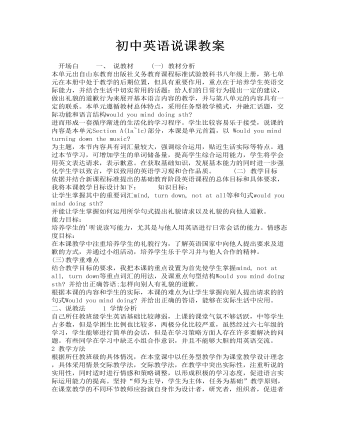
初中英语说课教案
(二) 教学目标 依据并结合新课程标准提出的基础教育阶段英语课程的总体目标和具体要求,我将本课教学目标设计如下: 知识目标: 让学生掌握其中的重要词汇mind, turn down, not at all等和句式would you mind doing sth? 并能让学生掌握如何运用所学句式提出礼貌请求以及礼貌的向他人道歉。
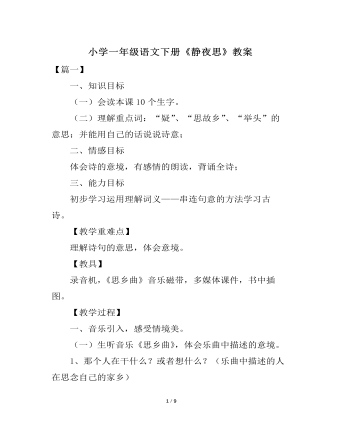
《静夜思》教案
(1)读整行诗。 (2)根据学生提出的问题理解“疑”的意思(怀疑、好像); “霜”(老师哈气在眼镜片上,并解释这是雾水,如果是冰粒,便是霜。霜在秋冬季节形成在地面附近:如房顶、草叶、地面等,堆起来是白色。) (3)说说这两行诗的意思。用上“什么好像是什么”的句式。(明亮的月光照在诗人的床前,好象是铺在地上的白白的霜) (4)朗读,引导。 诗人这样描写,给了你一种什么样的感觉?(冷清) 师描述:今晚,银白色的月光洒在地上,像铺了一层冰冷的霜一样。环境如此冷清,再加上诗人远离亲人的孤独,就更感到冷清了。
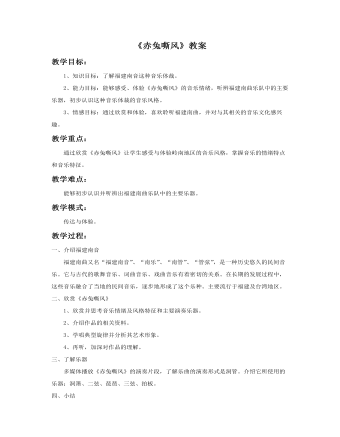
《赤兔嘶风》教案
一、介绍福建南音福建南曲又名“福建南音”、“南乐”、“南管”、“管弦”,是一种历史悠久的民间音乐。它与古代的歌舞音乐、词曲音乐、戏曲音乐有着密切的关系。在长期的发展过程中,这些音乐融合了当地的民间音乐,逐步地形成了这个乐种。主要流行于福建及台湾地区。二、欣赏《赤兔嘶风》1、欣赏并思考音乐情绪及风格特征和主要演奏乐器。2、介绍作品的相关资料。3、学唱典型旋律并分析其艺术形象。4、再听,加深对作品的理解。三、了解乐器多媒体播放《赤兔嘶风》的演奏片段,了解乐曲的演奏形式是洞管。介绍它所使用的乐器:洞箫、二弦、琵琶、三弦、拍板。
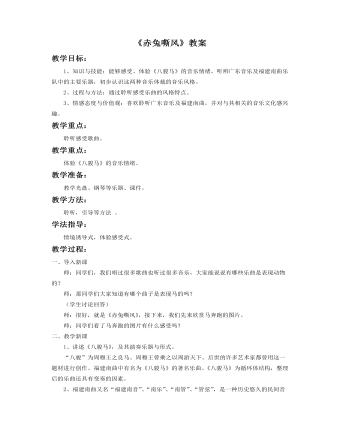
《赤兔嘶风》教案
一、导入新课师:同学们,我们唱过很多歌曲也听过很多音乐,大家能说说有哪些乐曲是表现动物的?师:那同学们大家知道有哪个曲子是表现马的吗?(学生讨论回答)师:很好,就是《赤兔嘶风》,接下来,我们先来欣赏马奔跑的图片。师:同学们看了马奔跑的图片有什么感受吗?二、教学新课1、讲述《八骏马》,及其演奏乐器与形式。 “八骏”为周穆王之良马。周穆王曾乘之以周游天下。后世的许多艺术家都曾用这一题材进行创作。福建南曲中有名为《八骏马》的著名乐曲。《八骏马》为循环体结构,整理后的乐曲还具有变奏的因素。2、福建南曲又名“福建南音”、“南乐”、“南管”、“管弦”,是一种历史悠久的民间音乐。它与古代的歌舞音乐、词曲音乐、戏曲音乐有着密切的关系。在长期的发展过程中,这些音乐融合了当地的民间音乐,逐步地形成了这个乐种。南曲包括了“指”、“谱”、“曲”三大部分。“指”是一种套曲;“谱”是有标题的器乐套曲;“曲”是有唱词的散曲,只唱不说。南曲的演奏形式有“上四管”、“下四管”之分。上四管以洞箫为主,叫做“洞管”;以笛子为主的叫做“品管”。
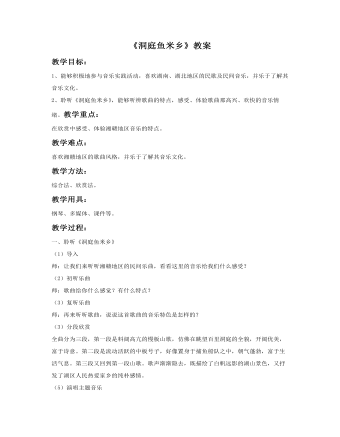
《洞庭鱼米乡》教案
一、聆听《洞庭鱼米乡》 (1)导入 师:让我们来听听湘赣地区的民间乐曲,看看这里的音乐给我们什么感受? (2)初听乐曲 师:歌曲给你什么感觉?有什么特点? (3)复听乐曲 师:再来听听歌曲,说说这首歌曲的音乐特色是怎样的?(3)分段欣赏全曲分为三段,第一段是料阔高亢的慢板山歌,仿佛在眺望百里洞庭的全貌,开阔优美,富于诗意。第二段是流动活跃的中板号子,好像置身于捕鱼船队之中,朝气蓬勃,富于生活气息。第三段又回到第一段山歌。歌声渐渐隐去,既描绘了白帆远影的湖山景色,又抒发了湖区人民热爱家乡的纯朴感情。(5)演唱主题音乐
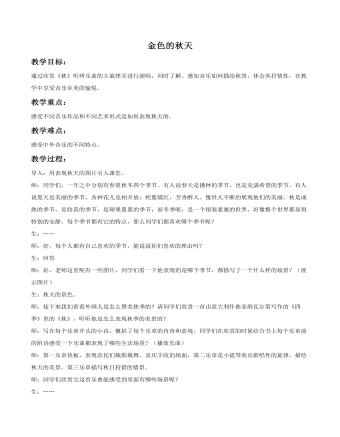
《秋》教案
导入:用表现秋天的图片引入课堂。师:同学们,一年之中分别有春夏秋冬四个季节。有人说春天是播种的季节,也是充满希望的季节,有人说夏天是美丽的季节。各种花儿竞相开放:姹紫嫣红,芳香醉人。像世人不断的展现他们的美丽,秋是成熟的季节,是收获的季节,是硕果累累的季节,而冬季呢,是一个银装素裹的世界,好像整个世界都显得特别的安静。每个季节都有它的特点,那么同学们都喜欢哪个季节呢?生:……师:好,每个人都有自己喜欢的季节,能说说你们喜欢的理由吗?生:回答师:好,老师这里呢有一些图片,同学们看一下他表现的是哪个季节,都描写了一个什么样的场景?(展示图片)生:秋天的景色。师:接下来我们看看外国人是怎么赞美秋季的?请同学们欣赏一首由意大利作曲家维瓦尔第写作的《四季》里的《秋》,听听他是怎么表现秋季的美景的?师:写在每个乐章开头的小诗,概括了每个乐章的内容和意境。同学们在欣赏的时候结合书上每个乐章前的附诗感受一下乐曲都表现了哪些生活场景?(播放乐曲)师:第一乐章快板,表现农民们载歌载舞、喜庆丰收的场面,第二乐章是小提琴奏出歌唱性的旋律,描绘秋天的美景。第三乐章描写秋日狩猎的情景。
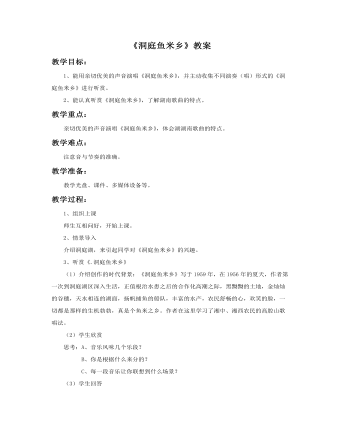
《洞庭鱼米乡》教案
教学过程:1、组织上课师生互相问好,开始上课。2、情景导入介绍洞庭湖,来引起同学对《洞庭鱼米乡》的兴趣。3、听赏《.洞庭鱼米乡》(1)介绍创作的时代背景:《洞庭鱼米乡》写于1959年,在1956年的夏天,作者第一次到洞庭湖区深入生活,正值根治水患之后的合作化高潮之际,黑黝黝的土地,金灿灿的谷穗,天水相连的湖面,扬帆捕鱼的船队,丰富的水产,农民舒畅的心,欢笑的脸,一切都是那样的生机勃勃,真是个鱼米之乡。作者在这里学习了湘中、湘西农民的高腔山歌唱法。(2)学生欣赏思考:A、音乐风味几个乐段?B、你是根据什么来分的?C、每一段音乐让你联想到什么场景?(3)学生回答
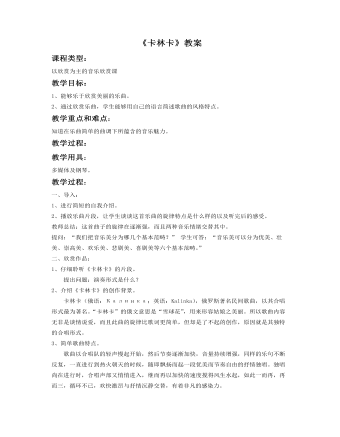
《卡林卡》教案
一、导入:1、进行简短的自我介绍。2、播放乐曲片段,让学生谈谈这首乐曲的旋律特点是什么样的以及听完后的感受。教师总结:这首曲子的旋律在逐渐强,而且两种音乐情绪交替其中。提问:“我们把音乐美分为哪几个基本范畴?” 学生可答:“音乐美可以分为优美、壮美、崇高美、欢乐美、悲剧美、喜剧美等六个基本范畴。”二、欣赏作品:1、仔细聆听《卡林卡》的片段。 提出问题:演奏形式是什么?2、介绍《卡林卡》的创作背景。卡林卡(俄语:Калинка;英语:Kalinka),俄罗斯著名民间歌曲,以其合唱形式最为著名。“卡林卡”的俄文意思是“雪球花”,用来形容姑娘之美丽。所以歌曲内容无非是谈情说爱,而且此曲的旋律比歌词更简单,但却是了不起的创作,原因就是其独特的合唱形式。
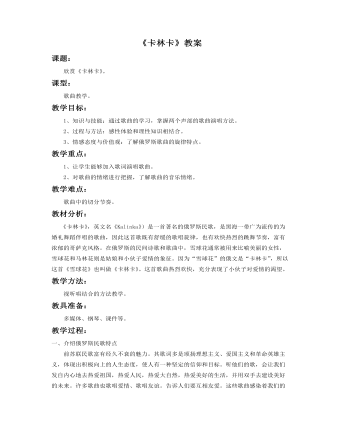
《卡林卡》教案
教学重点:1、让学生能够加入歌词演唱歌曲。2、对歌曲的情绪进行把握,了解歌曲的音乐情绪。教学难点:歌曲中的切分节奏。教材分析:《卡林卡》,英文名《Kalinka》)是一首著名的俄罗斯民歌,是黑海一带广为流传的为婚礼舞蹈伴唱的歌曲,因此这首歌既有舒缓的歌唱旋律,也有欢快热烈的跳舞节奏,富有浓郁的哥萨克风格。在俄罗斯的民间诗歌和歌曲中,雪球花通常被用来比喻美丽的女性,雪球花和马林花则是姑娘和小伙子爱情的象征。因为“雪球花”的俄文是“卡林卡”,所以这首《雪球花》也叫做《卡林卡》。这首歌曲热烈欢快,充分表现了小伙子对爱情的渴望。
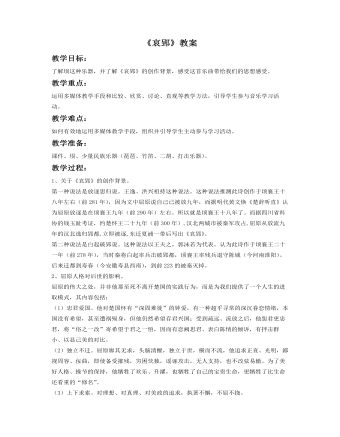
《哀郢》教案
关于《哀郢》的创作背景。第一种说法是放逐思归说。王逸、洪兴祖持这种说法。这种说法推测此诗创作于顷襄王十八年左右(前281年),因为文中屈原说自己已被放九年,而据明代黄文焕《楚辞听直》认为屈原放逐是在顷襄王九年(前290年)左右。所以就是顷襄王十八年了。而据四川省科协的钱玉趾考证,约楚怀王二十九年(前300年),汉北两城市被秦军攻占,屈原从放流九年的汉北逃归郢都,立即被逐,东迁夏浦一带后写出《哀郢》。第二种说法是白起破郢说。这种说法以王夫之,郭沫若为代表。认为此诗作于顷襄王二十一年(前278年),当时秦将白起率兵击破郢都,顷襄王率残兵退守陈城(今河南淮阳)。后来迁都到寿春(今安徽寿县西南),到前223的被秦灭掉。

《化蝶》教案
这是一部以广泛流传的民间故事《梁山伯与祝英台》为题材,以越剧音乐为素材而写成的单乐章小提琴协奏曲。如今已列入世界名曲,Butterfly-loves(《蝴蝶的爱情》)。小提琴协奏曲《梁山伯与祝英台》由何占豪、陈钢作曲。1959年写成并首演。当时作者是上海音乐学院的青年学生。他们为了探索交响音乐的民族化,选择了这一家喻户晓的民间传说为题材,吸取了越剧中的曲调为素材,成功地创作了这部单乐章、带标题的小提琴协奏曲。《梁山伯与祝英台》描述了梁、祝二人的真挚爱情,对封建礼教进行了愤怒的控诉与鞭笞,反映了人民反封建的思想感情及对这一爱情悲剧的深切同情。乐曲运用西洋协奏曲中的奏鸣曲式,很好地表现了戏剧性的矛盾冲突。并吸收了我国戏曲中丰富的表现手法,使之既有交响性又有民族特色。
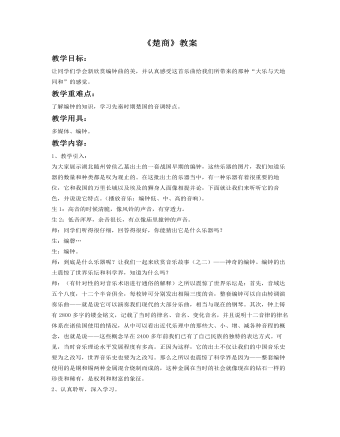
《楚商》教案
之所以震惊了世界乐坛是:首先,音域达五个八度,十二个半音俱全,每枚钟可分别发出相隔三度的音,整套编钟可以自由转调演奏乐曲——就是说它可以演奏我们现代的大部分乐曲,相当与现在的钢琴。其次,钟上铸有2800多字的镂金铭文,记载了当时的律名、音名、变化音名,并且说明十二音律的律名体系在诸侯国使用的情况,从中可以看出近代乐理中的那些大、小、增、减各种音程的概念,也就是说——这些概念早在2400多年前我们已有了自己民族的独特的表达方式。可见,当时音乐理论水平发展程度有多高。正因为这样,它的出土不仅让我们的中国音乐史要为之改写,世界音乐史也要为之改写。那么之所以也震惊了科学界是因为——整套编钟使用的是铜和锡两种金属混合烧制而成的,这种金属在当时的社会就像现在的钻石一样的珍贵和稀有,是权利和财富的象征。

《哀郢》教案
屈原 ( 约前340—约前278 ) 我国最早的大诗人。名平,字原;又自云名正则,字灵均。战国时楚国人。初辅佐怀王,做过左徒、三闾大夫。主张彰明法度,举贤任能,改革政治,联齐抗秦。后遭谗去职,迭遭放逐。至首都郢为秦兵攻破,遂投汨罗江而死。后世所见屈原作品,皆出自西汉刘向辑集的《楚辞》。这本书主要是屈原的作品,其中有《离骚》一篇,《九歌》十一篇:《东皇太一》、《云中君》、《湘君》、《湘夫人》、《大司命》、《少司命》、《东君》、《河伯》、《山鬼》、《国殇》、《礼魂》。《九章》九篇:《惜诵》、《涉江》、《哀郢》、《抽思》、《怀沙》、《思美人》、《惜往日》、《橘颂》、《悲回风》。《天问》一篇。等等。屈原是我国历史上伟大的爱国主义诗人,对屈原生平及作品特别是其爱国主义精神和高洁的品质,更有必要让学生了解、掌握和领会。
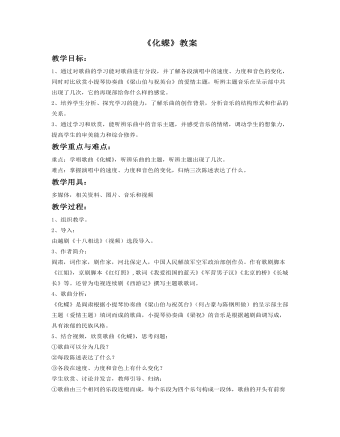
《化蝶》教案
教学过程:1、组织教学。2、导入:由越剧《十八相送》(视频)选段导入。3、作者简介:阎肃,词作家,剧作家,河北保定人,中国人民解放军空军政治部创作员。作有歌剧脚本《江姐》,京剧脚本《红灯照》,歌词《我爱祖国的蓝天》《军营男子汉》《北京的桥》《长城长》等。还曾为电视连续剧《西游记》撰写主题歌歌词。4、歌曲分析:《化蝶》是阎肃根据小提琴协奏曲《梁山伯与祝英台》(何占豪与陈钢所做)的呈示部主部主题(爱情主题)填词而成的歌曲,小提琴协奏曲《梁祝》的音乐是根据越剧曲调写成,具有浓郁的民族风格。5、结合视频,欣赏歌曲《化蝶》,思考问题:①歌曲可以分为几段?②每段陈述表达了什么?③各段在速度、力度和音色上有什么变化?学生欣赏、讨论并发言,教师引导、归纳:①歌曲由三个相同的乐段连缀而成,每个乐段为四个乐句构成一段体,歌曲的开头有前奏(引子),中间有间奏(经过句),实际上相当于一个乐段的三次反复